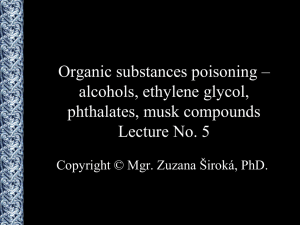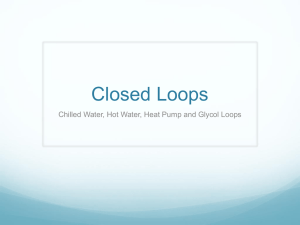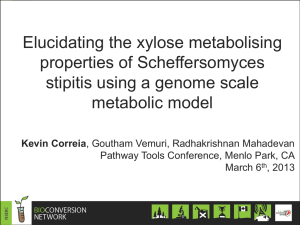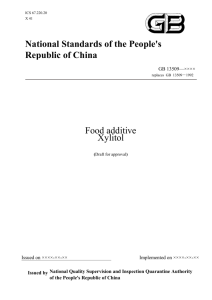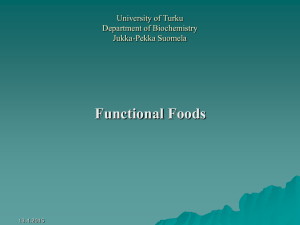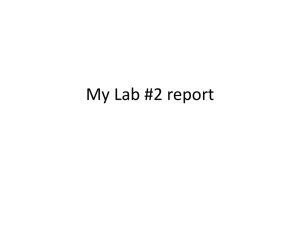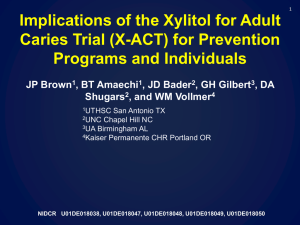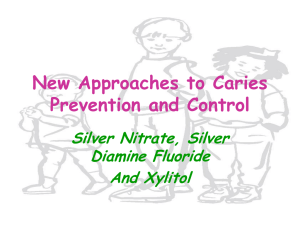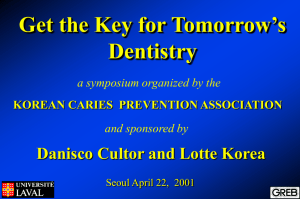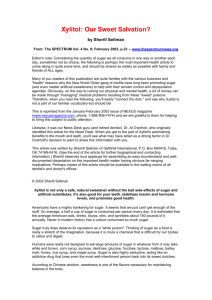MS PowerPoint
advertisement
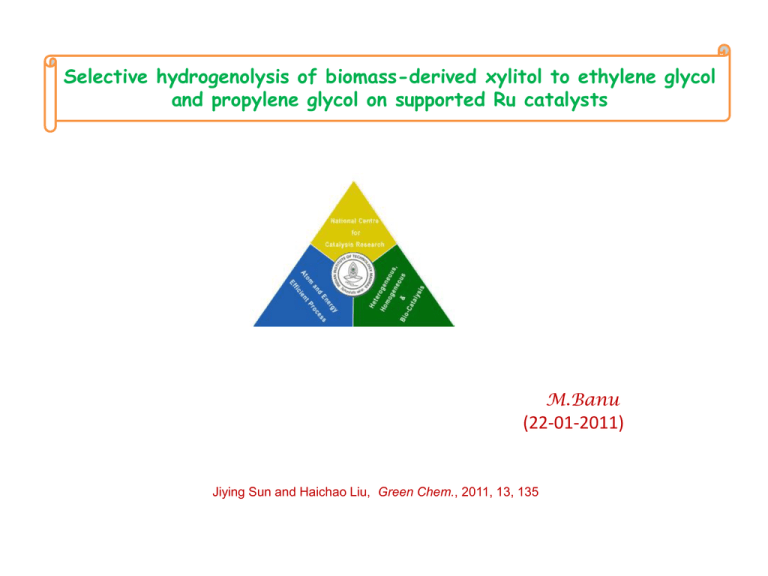
Selective hydrogenolysis of biomass-derived xylitol to ethylene glycol and propylene glycol on supported Ru catalysts M.Banu (22-01-2011) Jiying Sun and Haichao Liu, Green Chem., 2011, 13, 135 Introduction The use of renewable biomass provides a viable route to both alleviate the shortage of fossil fuels and reduce the CO2 emissions. In this context, biomass-derived polyols emerge as promising building blocks for liquid fuels and value-added chemicals from biomass. Among them, xylitol and sorbitol are especially noticeable because they are readily available from abundant lignocellulose, and can be converted to different products such as ethylene glycol, propylene glycol and glycerol. Ethylene glycol and propylene glycol are important commodity chemicals. They are widely used as functional fluids such as antifreezes and coolants, and as monomers in the synthesis of polyester fibers and resins, etc. Industrial production of ethylene glycol and propylene glycol is currently based on the multi-step transformation of petroleum-derived ethylene and propylene via their epoxide intermediates. In comparison with ethylene and propylene, xylitol and sorbitol are not only renewable, but also structurally analogous to ethylene glycol and propylene glycol with adjacent hydroxyl groups. These features render xylitol and sorbitol to be favorable feedstocks, in term of sustainability and energy efficiency, for the synthesis of the two glycols by catalytic hydrogenolysis. Hydrogenolysis of xylitol and sorbitol to ethylene glycol and propylene glycol requires cleavage of specific C–C and C–O bonds, which generally involves the use of Ni or Rubased catalysts and basic promoters. Relative to more extensively studied sorbitol, xylitol possesses a shorter chain and is more structurally advantageous in understanding the hydrogenolysis mechanism in term of formation of ethylene glycol and propylene glycol, the dominant products from both xylitol and sorbitol. The effects of supports and basic promoters on the activity and selectivity of the Ru catalysts were studied. The supports include activated carbon (C), ZrO2, TiO2, Al2O3 and Mg2AlOx with a wide range of acid-base and redox surface properties, and the bases include Ca(OH)2,Mg(OH)2 and CaCO3 resulting in different pH values in water. The catalytic activity and selectivity of Ru/C and other supported noble metal catalysts, Rh/C, Pd/C and Pt/C, in xylitol hydrogenolysis were compared, and also examine the effects of reaction parameters (e.g. pH, H2 pressure and temperature). Catalysts preparation (Wet Impregnation method) Supports ( AC, Monoclinic ZrO2, Alumina, TiO2, Mg2AlOx) + Acetone solution of (4 Wt% Ru) RuCl3.nH2O, (4 wt%) PdCl2, (8 wt%) H2PtCl6.6H2O, (4 wt%) RhCl3.nH2O Aqueous HCl Solution Dried at 110 °C Reduced at 400 °C Catalysts Reaction Conditions Substrate: 40g of 10 wt% Xylitol Catalyst amount: 0.1g Catalyst Ca(OH)2 : 0.26g Reactor: 100 ml Parr reactor Stirring Speed: 800 rpm Temperature: 473K °C Pressure; 40 bar The reactant and liquid products, after silylation with hexamethyldisilazane (HMDS) and trimethylchlorinesilane (TMSCl) (both ≥98.0%, SinopharmChemical) in pyridine (AR, Shantou Xilong Chemical), were analyzed by gas chromatography (Shimadzu 2010 GC) using a capillary column OV-101 and a flame ionization detector. The reactant and liquid products were also analyzed by high-performance liquid chromatography (Shimadzu LC-20A) using a PRP-X300 column at 304 K and a PDA detector. TEM micrographs and histograms of Ru particle size distribution for different Ru catalysts (a) Ru/Al2O3, 1.6 ±0.3 nm; (b) Ru/ZrO2, 1.7 ± 0.2 nm; (c) Ru/Mg2AlOx, 1.4 ± 0.3 nm; (d)Ru/TiO2, 1.8 ± 0.4 nm. Results and discussion Activities and selectivities in xylitol hydrogenolysis on different catalysts under basic conditionsa Catalyst Activity (h-1) Selectivity (on a carbon basis, %) EG PG G Threitol Arabitol Lactic acid Formic acid Ru/C 184.4 32.4 24.9 9.6 2.3 trace 16.8 2.3 Ru/ZrO2 87.8 24.2 20.5 9.6 3.2 trace 22.8 2.1 Ru/TiO2 66.7 30.0 24.0 8 2.3 trace 28.3 3.7 Ru/Al2O3 162.5 17.5 9 13.2 4.3 trace 25.2 1.6 Ru/Mg2AlOx 145.2 19.5 7.9 4.8 6.9 3.4 36.5 2.2 Pd/C 63.0 30.0 29.0 3.4 n.d.b n.d. 28.4 0.9 Rh/C 61.2 26.4 30.0 7.2 n.d. n.d. 23.3 4.6 Pt/C 754.5 25.0 23.3 10.5 n.d. 8.3 15.5 2.0 aReaction conditions: 473 K, 4.0 MPa H2, 0.02–0.20 g catalysts, 0.26–0.39 g Ca(OH)2, 40 g 10 wt% xylitol aqueous solution, 1 h, ~20% xylitol conversion. bNot detected. TEM micrographs and histograms of metal particle size distribution for Pd/C, Pt/C and Rh/C (a) Rh/C,1.7 ± 0.3 nm; (b) Pd/C, 1.8 ± 0.3 nm; (c) Pt/C, 1.9 ± 0.5 nm. Recyclability Activities and selectivities to ethylene glycol, propylene glycol and glycerol for the six reaction cycles of xylitol hydrogenolysis on Ru/C. Reaction conditions: 473 K, 4.0 MPa H2, 0.15 g Ru/C (4 wt% Ru), 0.33 g Ca(OH)2, 40 g 10 wt% xylitol aqueous solution,1 h. TEM micrographs and histograms of Ru particle size distribution of Ru/C before reaction and after six reaction cycles (scale bar =20 nm). (a) Before reaction, 1.7 ± 0.4 nm; (b) after six reaction cycles, 2.0 ± 0.3 nm. Product distribution on Ru/C catalyst Dependence of products selectivities on xylitol conversion for Ru/C. Reaction conditions: 473 K, 4.0 MPa H2, 0.10–0.40 g Ru/C (4 wt% Ru), 0.26–0.60 g Ca(OH)2, 40 g 10 wt% xylitol aqueous solution, 1–6 h. Effect of basicity Effects of solid bases (i.e. pH values) on activities and selectivities in xylitol hydrogenolysis on Ru/Ca Base PH b Selectivity (on a carbon basis, %) Activity (h-1) EG PG G Threitol Erithritol Arabitol Adonitol Lactic acid - 7.0 815 trace trace 3.5 8.3 2.9 67.8 12.6 n.d CaCO3 9.4 67.8 21.0 18.4 15.5 4.2 trace 14.9 trace 2.2 Mg(OH)2 10.7 116.2 24.5 21.0 16.8 3.7 trace 11.7 trace 4.1 Ca(OH)2 12.3 184.4 32.4 24.9 9.6 2.3 trace trace n.d. 16.8 a Reaction conditions: 473 K, 4.0 MPa H2, 0.02–0.20 g Ru/C (4 wt% Ru), 40 g 10 wt% xylitol aqueous solution, 1 h, ~20% xylitol conversion. b Measured at 298 K. Effect of Pressure Effects of H2 pressure on activities and selectivities for xylitol hydrogenolysis on Ru/C at ca. 25% conversion. Reaction conditions: 473 K, 0.10 g Ru/C (4 wt% Ru), 0.26 g Ca(OH)2, 40 g 10 wt% xylitol aqueous solution, 1 h. Effect of Temperature Effects of temperature on activities and selectivities for xylitol hydrogenolysis on Ru/C at ca. 25% conversion. Reaction conditions: 4.0 MPa H2, 0.02–0.20 g Ru/C (4 wt% Ru), 0.26 g Ca(OH)2, 40 g 10 wt% xylitol aqueous solution, 1–4 h. Mechanism Conclusion Supported noble metals, Ru, Pd, Rh and Pt efficiently catalyze xylitol hydrogenolysis into ethylene glycol and propylene glycol in the presence of Ca(OH)2. The activities and selectivities strongly depend on the nature of the metals and their underlying supports. Ru supported on C exhibits superior activities and glycol selectivities than on TiO2, ZrO2, Al2O3 and Mg2AlOx, and Pt is found to be the most active metal compared at similar particle sizes, apparently as a result of the difference in their dehydrogenation/hydrogenation activities and surface acidbasicities, and the consequent effects on the reaction pathways of xylitol hydrogenolysis. The activities and selectivities also depend largely on the H2 pressures, reaction temperatures, and pH values varied by using different solid bases, CaCO3, Mg(OH)2 and Ca(OH)2, which influence the hydrogenation and base-catalyzed steps involved in xylitol hydrogenolysis. Taken together, it is apparent that xylitol hydrogenolysis to ethylene glycol and propylene glycol proceeds by its kinetically relevant dehydrogenation of xylitol to xylose on the metal surfaces, and its subsequent base-catalyzed retro-aldol condensation to form glycolaldehyde and glyceraldehyde, the intermediates for the two glycols. The involved hydrogenation of the aldehyde intermediates on the metal surfaces and their competitive reactions with the bases clearly dictate the ultimate selectivities to the two glycols.

